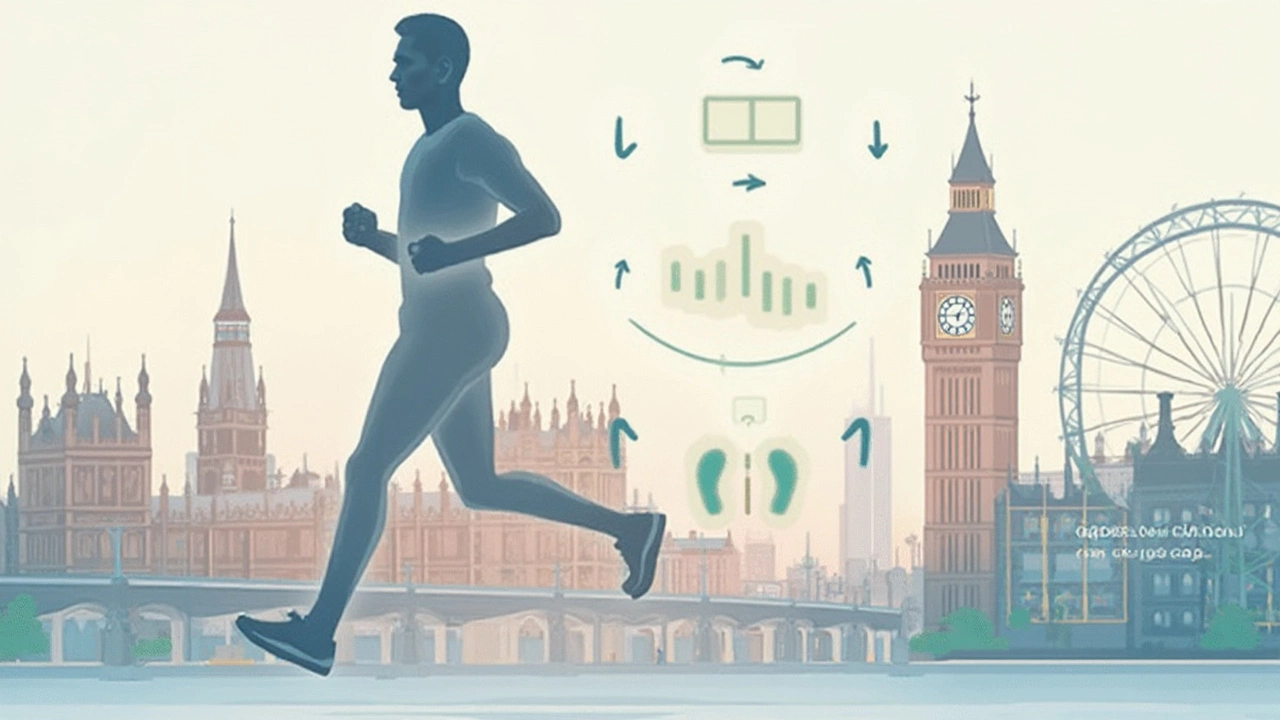
Running is a fantastic way to stay fit, but getting started can feel a bit confusing. One of the first things you'll hear about is 'cadence.' But what exactly does that mean? Cadence is simply the number of steps you take per minute while running. For beginners, finding a good cadence can make all the difference in your running experience.
So, why should you care about cadence? Well, a good cadence can help reduce the risk of injury and improve your running efficiency. Many pros recommend aiming for anywhere between 170 to 180 steps per minute. That might sound a bit fast at first, but don't worry—you don't have to hit that number overnight.
Start by figuring out your current cadence. Head out for a run, and count your steps for 15 seconds, then multiply by four. That's your starting number. From there, you can gradually work on increasing it, if needed, by focusing on shorter, quicker steps rather than trying to sprint flat out.
Alright, so let's really dig into what running cadence means. In simple terms, it's the number of steps you take in a minute while running. Think of it like a running rhythm or beat you want to stick to. It's different from pace, which is all about how fast you're covering distance. Cadence is about stepping speed, not ground speed.
When it comes to beginners, there's a common guideline in the running world: aim for a cadence of around 170-180 steps per minute. This isn't just some random number that gym rats throw around. Research from running experts shows that this range can reduce stress on your joints, which is super important if you're just starting out and want to avoid injuries.
Why does cadence reduce injury risk? Well, a higher cadence usually means that you're taking smaller, more frequent steps. This limits the up and down movement that puts unnecessary stress on your knees and hips. Plus, when you focus on improving cadence, you're likely to land more towards your midfoot instead of your heel. This can really help in cutting down that pounding feeling you might get on hard surfaces.
Another cool thing about focusing on running cadence: it can make you more efficient. Imagine using less energy but still covering the same distance. Better cadence helps your muscles to do just that by optimizing their work. Over time, this efficiency can lead to longer, more enjoyable runs with less fatigue.
Fun fact: Legendary coach Jack Daniels, a huge name in the running community, studied elite runners and found that most of them have a cadence near that 180 mark, regardless of their speed. So, while you're not trying to break world records, following their cue could help you have a smoother run.
Now, this doesn't mean you have to run like a rabbit to up your cadence. It's not about speeding up, but rather tightening how often your feet hit the ground. Slower steps even at a higher cadence help maintain an easy pace, which is great when you're still getting the hang of running.
Check out some running apps or metronomes online; they make it easier and fun to keep track of your steps and gradually increase that beginners' running cadence.
When it comes to running, cadence isn't just a fancy term thrown around by experts. It really plays a crucial role in how well you perform and stay injury-free. You might be wondering how something like steps per minute can make such a big difference. Well, let's break it down.
A higher running cadence often means fewer injuries. When you take more steps per minute, the impact forces are more evenly distributed. This can help prevent common running injuries like shin splints or knee pain. And honestly, who wants to be sidelined from running because of an injury?
Running is not just about moving your legs; it's about moving smartly. A higher cadence usually means you're taking shorter, quicker steps. This reduces the time your feet spend hitting the ground, cutting down on energy waste. It might sound technical, but basically, it means you can run faster without feeling like you're running a marathon every time.
Trying to maintain a good cadence encourages you to focus on your form, which is crucial, especially for beginner runners. You'll naturally start running more upright and with your feet landing more under you rather than in front. This can lead to a more comfortable and natural stride overall.
Now, you might be asking what cadence is right for beginners. Professionals often suggest aiming around 170 to 180 steps per minute for the best results. Don't stress if you're not there yet—what matters is steady improvement.
Still not convinced? Check out this small table highlighting some benefits of improved cadence:
| Benefit | Impact |
|---|---|
| Reduced Ground Contact | Less energy waste |
| Better Posture | Enhanced form and comfort |
| Fewer Injuries | Lower risk of common injuries |
So if you want to enjoy your running journey and see progress, paying attention to cadence is definitely worth it. Start small, aim for steady improvements, and keep an eye on those steps per minute. You got this!

Before diving into improving your running cadence, it's crucial to know where you're starting from. Finding your baseline cadence involves a little bit of math, but don't worry, it's pretty straightforward.
For instance, if you count 40 steps in 30 seconds with one foot, your total for both feet in the same time is 80. Doubling that gives you a cadence of 160 steps per minute.
Having this baseline is invaluable. It tells you if you're naturally on the lower end and need to work on increasing your steps, or if you're already in a good spot. Most beginner runners find themselves around the 150-160 steps per minute mark, so there's plenty of room for improvement.
| Cadence Range | Classification |
|---|---|
| 150-160 | Beginner |
| 160-170 | Intermediate |
| 170-180 | Advanced |
Having your baseline is like a starting point on a map—it shows you where you are and helps you plan where you want to go next in your running journey.
Improving your cadence might seem tricky, but with a few specific techniques, you’ll be running smoother in no time. Let's dive into some practical tips to help boost your cadence, making your runs more efficient and enjoyable.
One of the first things you'll want to focus on is taking shorter but quicker strides. This doesn’t mean speeding up your pace drastically; rather, it’s about maintaining a consistent rhythm. You might find it helpful to count your steps over a minute or so and gradually up that number by just 5% each week. It’s all about those small improvements.
Did you know there are apps that can function like a metronome set to the beat of your desired running pace? By matching your steps to the beat, you can fine-tune your running cadence without the stress of complex math. Using a metronome can also help you maintain focus, especially if the temptation to slow down creeps in.
Certain drills can be super effective in upping that step rate. Try running in place with quick, light steps for 30 seconds, then step it up for the next round. Integrate these into your regular workouts to gradually adjust your natural rhythm.
It might sound weird, but more strength and flexibility can positively impact your running form and cadence. Stronger muscles and increased flexibility can help you make those quicker, more efficient movements. Consider adding some core, leg, and mobility exercises to your routine, and you’ll likely notice a smoother, faster cadence.
There are great running apps and wearables that can track your strides. By keeping an eye on your statistics, you're more aware of your running habits and progress. Many beginners find their running plans are boosted by such data-driven insights.
Noteworthy Stats:
| Cadence Level | Effects |
|---|---|
| Below 160 steps/min | Higher injury risk |
| 170-180 steps/min | Optimal for beginners |
Boosting your cadence isn't just for the pros. With a bit of effort and the right strategy, you'll find yourself running more efficiently and comfortably, making each run a little bit easier and a whole lot more fun.

Sticking with your running plan can be tough, especially when life gets busy or you hit a plateau. Keeping your motivation up is key to making progress, whether you're working on your running cadence or just trying to enjoy your runs more.
First off, set goals that are challenging yet achievable. Instead of aiming to run a marathon in a month, plan to run a 5k or aim to increase your distance a bit each week. Once you hit those goals, you'll feel a sense of accomplishment that keeps you coming back for more.
Monitoring how you're doing can give you a real boost. Use apps or a simple journal to note down your cadence improvements and how you're feeling after each run. Watching those numbers improve can be incredibly rewarding.
Running groups, either online or in-person, can help keep the energy high. You'll likely learn new tips about beginner runner tips and even pick up some friendly competition. Sometimes, knowing that someone is cheering you on makes all the difference.
Don’t just focus on the big goals; remember to celebrate the smaller victories. Maybe you shaved a few seconds off your mile time or hit a new running technique milestone. Celebrate these wins and remind yourself of the progress you’re making.
Doing the same routine over and over can get boring. Try different routes, change up your pace, or add some fun playlists to your running sessions. Keeping things fresh can make your runs something to look forward to.